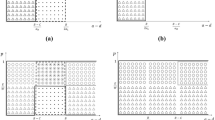Abstract
This paper tests for self-interested behavior by local-government bureaucrats engaged in collective bargaining with public employee unions. A theoretical model is developed that shows the effect of Niskanen-style bureaucratic self-interest in the two standard bargaining models: the demand-constrained model and the efficient-bargain model. These predictions are then tested using national cross-section data on unionized police, fire, and sanitation workers.
Similar content being viewed by others
References
Ashenfelter, O. (1971). The effect of unionization on wages in the public sector: The case of firefighters. Industrial and Labor Relations Review 24 (January): 191–202.
Bartel, A., and Lewin, D. (1981). Wages and unionism in the public sector: The case of police. Review of Economics and Statistics 63 (February): 53–59.
Bergstrom, T.C., and Goodman, R.P. (1973). Private demands for public goods. American Economic Review 63 (June): 280–296.
Borcherding, T.E., and Deacon, R.T. (1972). The demand for the services of non-federal governments. American Economic Review 62 (December): 891–901.
Brown, J.N., and Ashenfelter, O. (1986). Testing the efficiency of employment contracts. Journal of Political Economy 94 (June): S40-S87.
Brueckner, J.K. (1988). Estimating a bargaining contract curve: Prior restrictions and methodology. Unpublished paper.
Courant, P.N., Gramlich, E.M., and Rubinfeld, D.L. (1979). Public employee market power and the level of public spending. American Economic Review 69 (December): 806–817.
Eberts, R.W., and Stone, J.A. (1986). On the contract curve: A test of alternative models of collective bargaining. Journal of Labor Economics 4 (January): 66–81.
Edwards, L.N., and Edwards, F.R. (1982a). Public unions, local government structure, and the compensation of municipal sanitation workers. Economic Inquiry 20 (July): 405–425.
Edwards, L.N., and Edwards, F.R. (1982b). Wellington and Winter revisited: The case of municipal sanitation collection. Industrial and Labor Relations Review 35 (April): 307–318.
Ehrenberg, R.G. (1973a). The demand for state and local government employees. American Economic Review 63 (June): 366–379.
Ehrenberg, R.G. (1973b). Municipal government structure, unionization, and the wages of firefighters. Industrial and Labor Relations Review 27 (October): 36–48.
Ehrenberg, R.G., and Goldstein, G.S. (1975). A model of public sector wage determination. Journal of Urban Economics 2 (July): 223–245.
Hall, W.C., and Vanderporten, B. (1977). Unionization, monopsony power, and police salaries. Industrial Relations 16 (February): 94–100.
Hamilton, B.W. (1978). Zoning and the exercise of monopoly power. Journal of Urban Economics 5 (January): 116–130.
Hamilton, B.W. (1983). The flypaper effect and other anomalies. Journal of Public Economics 22 (October): 347–361.
Ichniowski, C. (1980). Economic effects of the firefighter's union. Industrial and Labor Relations Review 33 (January): 198–211.
Landon, J.H., and Baird, R.N. (1971). Monopsony in the market for public school teachers. American Economic Review 61 (December): 966–971.
MaCurdy, T.E., and Pencavel, J.H. (1986). Testing between competing models of wage and employment determination in unionized markets. Journal of Political Economy 94 (June): S3-S39.
McDonald, I.M., and Solow, R.M. (1981). Wage bargaining and employment. American Economic Review 71 (December): 896–908.
McGuire, T.G. (1981). Budget-maximizing government agencies: An empirical test. Public Choice 36: 313–322.
Mehay, S.L., and Gonzalez, R.A. (1986). The relative effect of unions and interjurisdictional competition on municipal wages. Journal of Labor Research 7 (Winter): 79–93.
Migue, J., and Berlanger, G. (1974). Toward a general theory of managerial discretion. Public Choice 17 (1): 27–43.
Moene, K.O. (1986). Types of bureaucratic interaction. Journal of Public Economics 29 (April): 333–345.
Nelson, W.B., Stone, G.W., Jr., and Swint, J.M. (1981). An economic analysis of public sector collective bargaining and strike activity. Journal of Labor Research 2 (Winter): 77–98.
Niskanen, W. (1971). Bureaucracy and representative government. New York: Aldine.
Ott, M. (1980). Bureaucracy, monopoly and the demand for municipal services. Journal of Urban Economics 8 (November): 362–382.
Orzechowski, W. (1977). Economic models of bureaucracy: Survey, extensions, and evidence. In T.E. Borcherding (Ed.), Budgets and bureaucrats, 229–259. Durham, NC: Duke University Press.
Romer, T., and Rosenthal, H. (1979). Bureaucrats versus voters: On the political economy of resource allocation by direct democracy. Quarterly Journal of Economics 93 (November): 563–587.
Romer, T., and Rosenthal, H. (1982). Median voters or budget maximizers: Evidence from school expenditure referenda. Economic Inquiry 20 (October): 556–578.
Schmenner, R. (1973). The determination of municipal employee wages. Review of Economics and Statistics 55 (February): 83–90.
Shapiro, P., and Sonstelie, J. (1982). Did Proposition 13 slay Leviathan? American Economic Review Papers and Proceedings 72 (May): 184–190.
Sjoquist, D.L. (1982). The effect of the number of local governments on central city expenditures. National Tax Journal 35 (March): 79–87.
Tiebout, C.M. (1956). A pure theory of local expenditure. Journal of Political Economy 64 (October): 416–424.
Zax, J.S. (1985a). Economic effects of municipal government institutions. National Bureau of Economic Research Working Paper #1657.
Zax, J.S. (1985b). Labor relations, wages and nonwages compensation in municipal employment. National Bureau of Economic Research Working Paper #1582.
Author information
Authors and Affiliations
Additional information
We wish to thank the Institute for Government and Public Affairs at the University of Illinois for its support of this research. Also, we thank Larry Kahn, Fran Blau, and Pablo Spiller for useful comments. Errors, of course, are ours.
Rights and permissions
About this article
Cite this article
Brueckner, J.K., O'Brien, K.M. Modeling government behavior in collective bargaining: A test for self-interested bureaucrats. Public Choice 63, 15–41 (1989). https://doi.org/10.1007/BF00223270
Issue Date:
DOI: https://doi.org/10.1007/BF00223270




